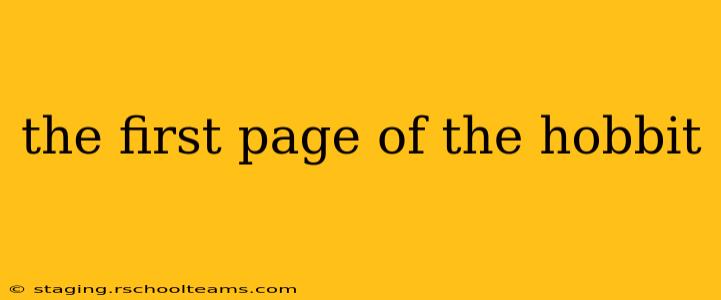J.R.R. Tolkien's The Hobbit, a seemingly simple children's story, opens with a deceptively profound first page that sets the tone and themes for the entire epic adventure to come. This isn't just a whimsical introduction; it's a carefully crafted narrative tapestry woven with threads of comfort, mystery, and the unexpected. Let's delve into the opening lines and explore what makes them so captivating.
"In a hole in the ground there lived a hobbit. Not a nasty, dirty, wet hole, filled with worms and an oozy smell, nor yet a dry, bare, sandy hole with nothing in it to sit down on or to eat: it was a hobbit-hole, and that means comfort."
This seemingly simple sentence immediately establishes several key elements:
-
Setting the Scene: The immediate imagery of "a hole in the ground" is both intriguing and slightly unsettling. It hints at hidden lives and the unexpected nature of the story to come. The subsequent clarification — "Not a nasty, dirty, wet hole..." — immediately contrasts the negative with the positive, highlighting the comfort and coziness associated with hobbit-holes.
-
Introducing the Protagonist: The introduction of the hobbit is understated yet effective. We learn about his dwelling before we even know his name, emphasizing the importance of home and comfort in his life. The description establishes a sense of familiarity and ordinariness that will later be contrasted with the extraordinary journey he will undertake.
-
Establishing Tone and Style: The playful, almost whimsical tone, coupled with the precise descriptive language ("oozy smell," "dry, bare, sandy hole"), immediately establishes Tolkien's unique style, a blend of fantasy and everyday realism.
What Makes a Hobbit-Hole Different?
This question, implicit in the first paragraph, is central to understanding the entire narrative. What defines a hobbit-hole? It's not just a house; it represents a lifestyle, a value system. The comfort described isn't mere luxury; it's a fundamental aspect of hobbit culture. It’s about warmth, security, and a connection to the earth. This emphasis on comfort and domesticity provides a stark contrast to the dangers and uncertainties that Bilbo Baggins will soon face.
Is The Hobbit a Children's Story?
Many readers approach The Hobbit as purely a children’s book, but the first page hints at the book’s complexities. While the simple language and whimsical setting might appeal to younger readers, the underlying themes of adventure, self-discovery, and facing the unknown resonate with readers of all ages. The seemingly simple description of the hobbit-hole is a subtle introduction to the more profound themes explored throughout the novel.
What are Hobbits Like?
The opening paragraph doesn't just describe a hole; it implicitly characterizes hobbits. We understand their appreciation for comfort and their connection to nature through the vivid description of their homes. This initial characterization sets the stage for Bilbo Baggins' later development as he moves beyond his comfort zone. The description creates a strong sense of place and culture before introducing the main character himself.
What Happens After the First Page?
The first page of The Hobbit masterfully lays the groundwork for what's to come. It's a carefully orchestrated introduction that promises adventure while simultaneously grounding the narrative in the comforting familiarity of hobbit life. The subsequent pages introduce Bilbo Baggins, Gandalf, and the unexpected arrival of dwarves, all setting the stage for a journey far beyond the cozy confines of Bag End.
The opening page of The Hobbit is more than just an introduction; it's a microcosm of the entire novel, perfectly balancing the elements of fantasy and reality, comfort and adventure, the familiar and the unknown. It's a masterclass in storytelling, demonstrating Tolkien's ability to captivate readers with seemingly simple yet deeply evocative prose.
